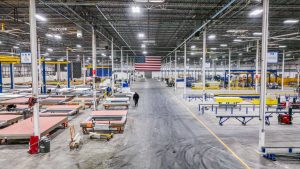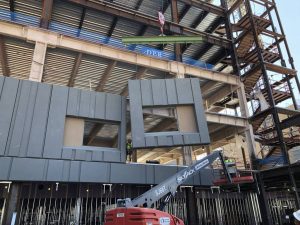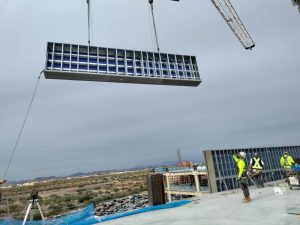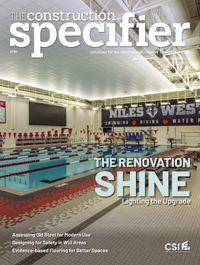CFS fabricator gets engineering award for complex Arizona project

Digital Building Components (DBC), the cold-formed steel (CFS) fabricator for the Mayo West Tower project in Phoenix, Arizona, has been awarded the 2023 Cold-Formed Steel Engineers Institute (CFSEI) award for design excellence (municipal/services category) for its innovative design solution to the hospital expansion’s facade.
The Mayo West Tower, a seven-story building addition, with approximately 13,006 m2 (140,000 sf) of prefinished exterior CFS non-load bearing wall panels, aims to expand clinical programs and increase the capacity of the existing hospital. The structure of the building consists of concrete over metal deck with steel moment frames and prefinished exterior CFS non-load bearing wall panels.
For this project, Pangolin Structural worked in the capacity of CFS specialty engineer, alongside DBC. DBC manufactured around 1,500 prefinished wall panels with preinstalled windows, measuring approximately 7.3 m (24 ft) in length and 4.6 m (15 ft) in height.

One notable aspect of the Mayo Tower is the size of the panels. The panel walls are 610 mm (24 in.) thick, with 152 mm (6 in.) exterior insulation and finish systems (EIFS) placed over 152 mm (6 in.) J girts, which are positioned over 305 mm (12 in.) studs. At the start of the project, DBC’s design team wanted to explore different ways to fabricate a 610-mm (24-in.)-thick wall that is 7.3-m (24-ft) long, with preinstalled windows. The team decided to use 305-mm (12 in.) as the first layer of the wall and then place the J girts horizontally over this layer, providing support for these long panels to be safely shipped and raised.
To address the challenge of transitioning from a 610-mm (24-in.)-thick wall to a 152-mm (6-in.)-thick wall for hoisting, the panels were fabricated by DBC and Pangolin as separate pieces and connected with welds to lift them as one unit.
In addition, there was a transition from a 610-mm (24-in.)-thick wall panel to a 102-mm (4-in.)-thick wall within window openings. To overcome this, DBC and Pangolin extended the header within the 305 mm (12 in.) studs and added 64 mm (2.5 in.) studs as infill to ensure a smooth transition. This approach allowed for a reduction in the gauge of the 64 mm (2.5 in.) studs, resulting in cost savings for the client.

Another unique feature in the Mayo West Tower is the sloped windowsills, which were achieved by adding an angled bent plate with 64 mm (2.5 in.) studs to the traditional windowsills with a 305 mm (12 in.) track.
A few wall panels in the project had unique shapes with “L” and “Z” configurations around corners. For example, one wall extends 9.1 m (30 ft) in length, but is only 1.8 m (6 ft) wide with an “L” shaped corner extending 0.9 m (3 ft) out from the main panel. To strengthen the connection between the main and sub panel, DBC and Pangolin implemented boxed studs and CFS straps as “X” bracing. These “L” panels also required connection to a narrow strip of slab that is only 305 mm (12 in.) wide and extends 2.1 m (7 ft) from the main building. The solution involved stacking these panels by two floors to simplify installation.

Designing the parapet walls posed another unique challenge. To account for the future vertical expansion of the hospital, panel splices were incorporated within the main walls and stitched with screws to the lower panels, allowing for easy removal in the future.
For the project, the architect of record was HKS, Inc., and the engineer of record for structural work was PK Associates.


